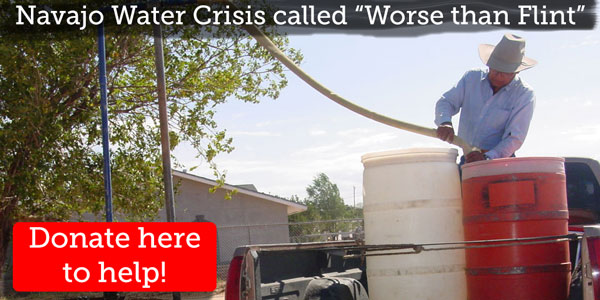|
Navajo water sources have been contaminated sine the 1950s. Their citizens are forced to live on less than 10 gallons of water per day, compared to the U.S. average of 100 gallons a day, and 67 percent don't have access to running water. Please donate $50 or more to help the Navajo get access to freshwater sources and bring their invisible water crisis to light.
Friend,
Flint, Michigan became the poster child for environmental racism when government officials switched the city's water source to contaminated river water to save money and caused a lead pollution crisis.1 Flint's crisis drew a ton of attention, especially right before the Michigan primary, but there's been little action to help.2 Even Flint, however, is ahead of the Navajo Nation who have been suffering a critical water crisis with no national attention for decades.
American Indians were not permitted to vote until 1948 in New Mexico and Arizona, where many Navajo live. This prevented them from having any say in the allocation of water rights,3 and since the 1950s the Navajo's water sources have been contaminated by uranium mining, toxic pollution and coal ash.4
As a result, Navajo members are 60 times more likely than other Americans to live without running water or a toilet. And because they have little access to clean, safe drinking water, they have to travel 100 miles or rely on the kindness of people like the "Water Lady" to access clean water.5 This is not right, not fair, it's not justice and no one is doing anything to help. That all changes right now. Please donate $50 or more to assist the Navajo with building a water filtration system that will allow them to access safe, clean drinking water and live in the dignity their great people deserve.

It's hard to believe the injustice experienced by First Citizens all across the United States. No group of people in this country have experienced more injustice than Native Americans, whose oppression basically starts with the founding of our country. But while many racial/ethnic groups have received some forms of remediation, Native Americans like the Navajo see a U.S. government that still implements injustice. For instance, there is still no law that requires the clean-up of 15,000 abandoned uranium wells nationwide, 75 percent of which are on Navajo and Federal lands.4 The lack of oversight has resulted in a license to poison Navajo land and water with no fear of retribution.
After last year's Los Animas mine spill, the EPA sent the Navajo fresh water in bins that were previously used to hold Oil and Fracking Fluid. When they rejected the shipments of dirty water, 40 percent of their homes had no running water.6 And last year Senator John McCain (R-AZ) snuck a provision into an unrelated bill that allowed for increased copper mining on and near Navajo lands resulting in even more water contamination.5 The Navajo have no reason to trust the corporations that poison their water, and they have no reason to trust the U.S government that continues to allow this to happen.
Without assistance from you and me, a dire situation is only going to get worse. In fact, the advocacy group, Clean Up The Mines, has described the situation on Navajo lands as, "far worse than Flint." It's time to show our friends from the Navajo Nation that we see them, that their water crisis is not invisible and that we are ready to stand with and help them. Please click here to donate whatever you can to help the Navajo get access to fresh water, independent of the U.S government.
Thanks for standing with Navajo,
Anthony for Environmental Action
1. Ruttenberg, Roee. Putting a Human Face on the Water Crisis in Flint, Michigan. CCTV America. May 8, 2016.
2. Finley, Nolan. Editor's Note: Clinton is Gone, and Flint Forgotten. The Detroit News. April 20, 2016.
3. Laughlin, Christina. Flint is Not The Only Water Crisis America Ignored. Huffington Post. February 23, 2016.
4. Gardner, Justine. Navajo Water Supply is More Horrific Than Flint, But No One Cares Because The're Native American. The Free Thought Project.com. January 31, 2016.
5. Morales, Laurel. For Many Navajo, A Visit From the 'Water Lady' is a Refreshing Sight. NPR: Code Switch. January 6, 2015.
6. Laylin, Tafline. Navajo Leader Feels Betrayed by EPA Over 'Contaminated' Water Supply. The Guardian. August 21, 2015.
|
